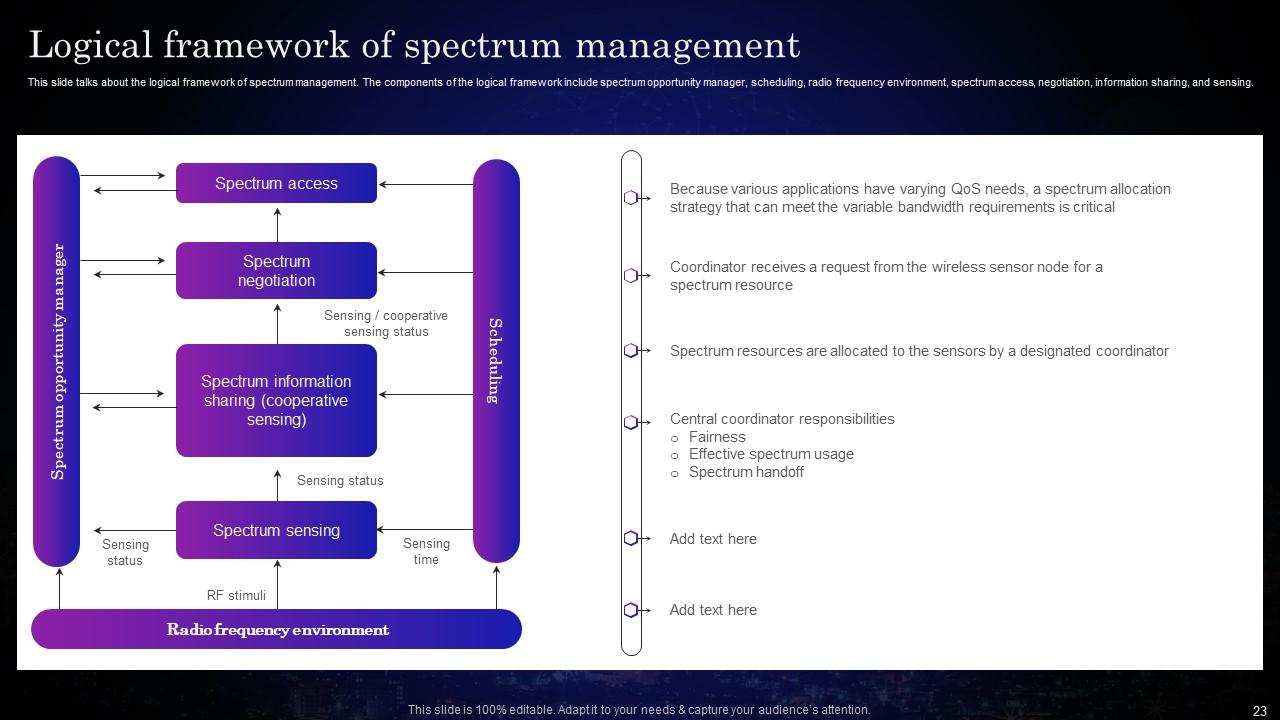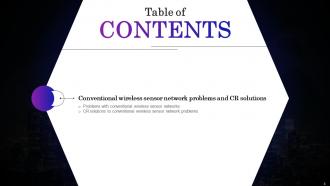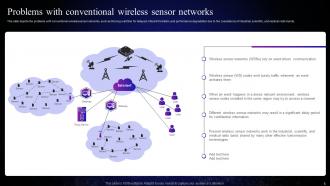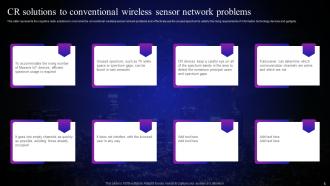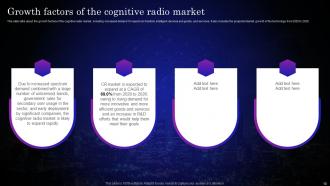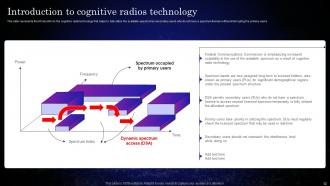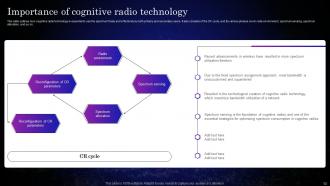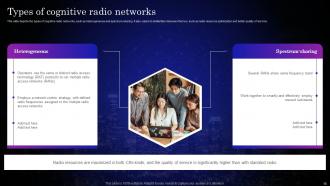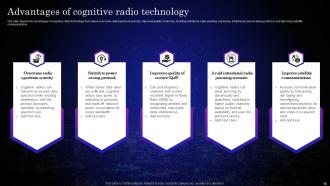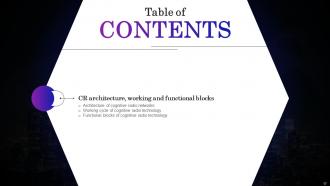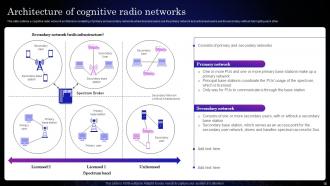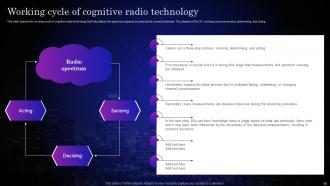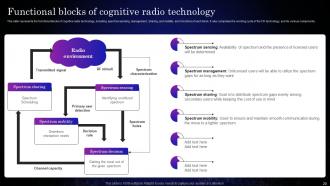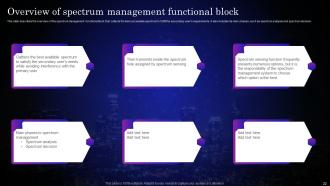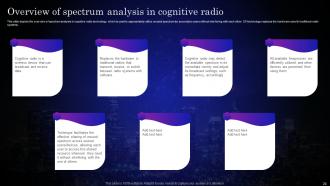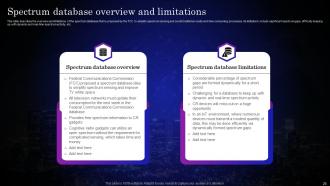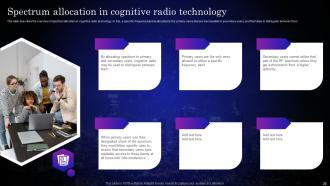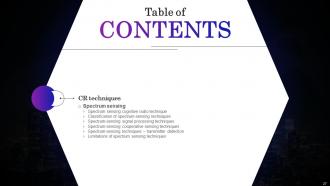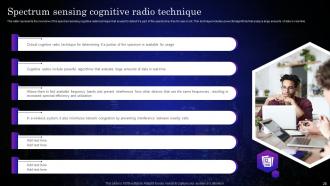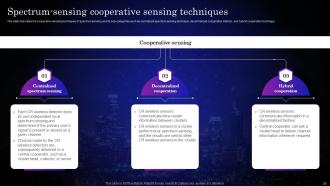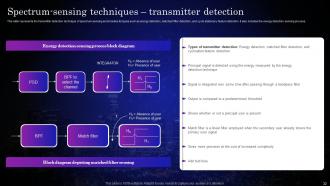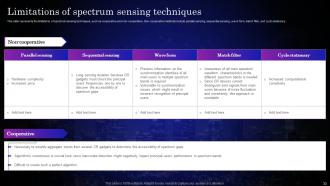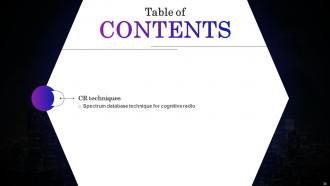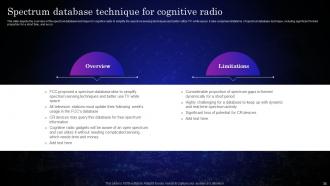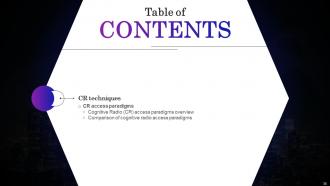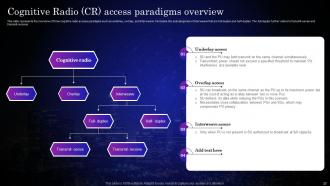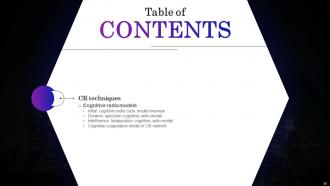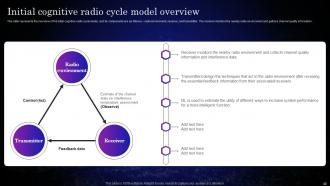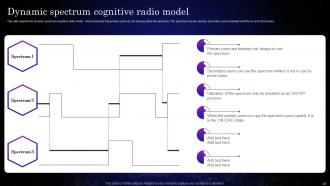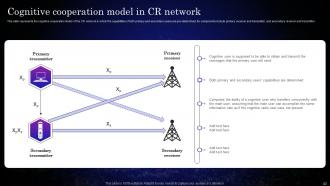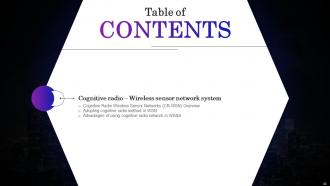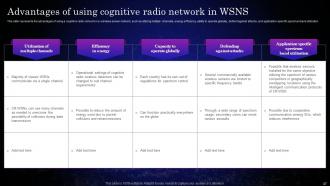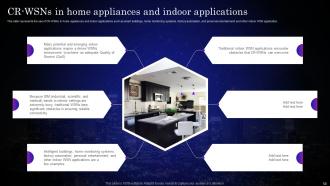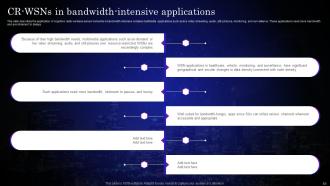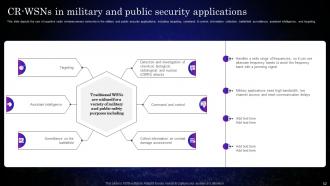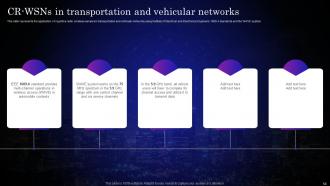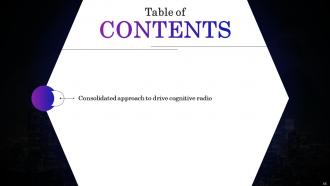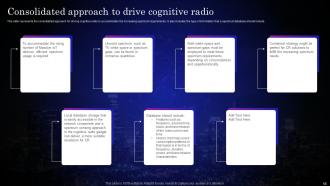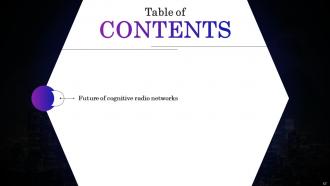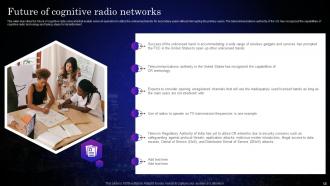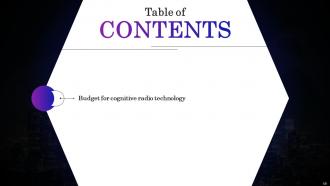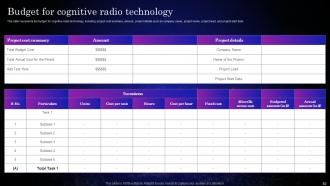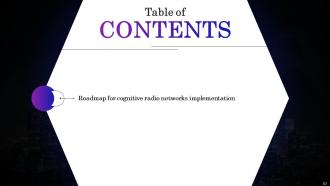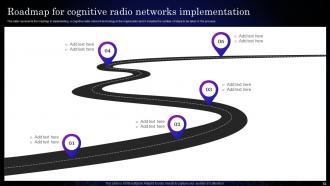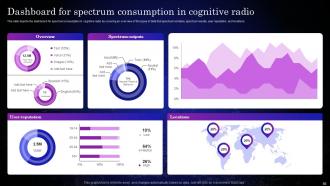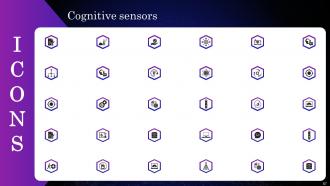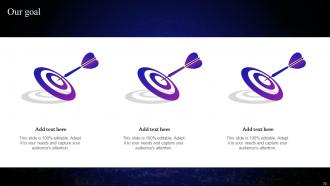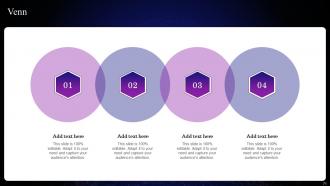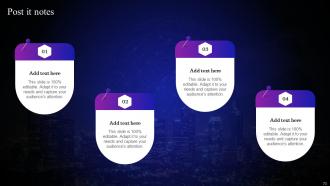Cognitive Sensors Powerpoint Presentation Slides
This PowerPoint presentation provides a concise overview of the potential of cognitive radio technology. The Cognitive Sensors PowerPoint Deck covers various aspects, including the global market size, market share by type, and growth factors of cognitive radio technology. Firstly, it offers a comprehensive introduction to cognitive radio, emphasizing its importance, characteristics, types, and advantages. The Sensor Networks PPT explores the architecture, working principles, and functional blocks of cognitive radio, along with an overview of the CR spectrum. It delves into spectrum management, including its logical framework, spectrum analysis, database, and allocation. The presentation also discusses spectrum sensing techniques, signal processing, and cooperative sensing methods. Moreover, it covers cognitive radio access paradigms, models, and their applications. Lastly, the Cognitive Radio Technology PPT presents a consolidated approach to drive cognitive radio implementation, along with a budget, timeline, roadmap, and dashboard for monitoring spectrum consumption. This highly customizable template is compatible with Google Slides, ensuring ease of use. Download now to access this valuable resource.
You must be logged in to download this presentation.
 Impress your
Impress your audience
Editable
of Time
PowerPoint presentation slides
Deliver this complete deck to your team members and other collaborators. Encompassed with stylized slides presenting various concepts, this Cognitive Sensors Powerpoint Presentation Slides is the best tool you can utilize. Personalize its content and graphics to make it unique and thought-provoking. All the seventy five slides are editable and modifiable, so feel free to adjust them to your business setting. The font, color, and other components also come in an editable format making this PPT design the best choice for your next presentation. So, download now.
People who downloaded this PowerPoint presentation also viewed the following :
Content of this Powerpoint Presentation
Slide 1: This slide introduces Cognitive Sensors. State your company name and begin.
Slide 2: This is an Agenda slide. State your agendas here.
Slide 3: This slide shows Table of Content for the presentation.
Slide 4: This slide shows title for topics that are to be covered next in the template.
Slide 5: This slide describes the problems with conventional wireless sensor networks.
Slide 6: This slide represents the cognitive radio solutions to overcome the conventional wireless sensor network problems.
Slide 7: This slide shows title for topics that are to be covered next in the template.
Slide 8: This slide represents the global market size of cognitive radio technology.
Slide 9: This slide presents the overview of the global cognitive radio market share by type.
Slide 10: This slide talks about the growth factors of the cognitive radio market.
Slide 11: This slide shows title for topics that are to be covered next in the template.
Slide 12: This slide contains the introduction to the cognitive radio technology.
Slide 13: This slide outlines how cognitive radio technology is essential to use the spectrum freely and effectively by both primary and secondary users.
Slide 14: This slide presents key characteristics of a cognitive radio network.
Slide 15: This slide depicts the types of cognitive radio networks, such as heterogeneous and spectrum-sharing.
Slide 16: This slide describes the advantages of cognitive radio technology.
Slide 17: This slide shows title for topics that are to be covered next in the template.
Slide 18: This slide presents a cognitive radio network architecture consisting of primary and secondary networks.
Slide 19: This slide depicts the working cycle of cognitive radio technology that fully utilizes the spectrum capacity by sharing the unused channels.
Slide 20: This slide represents the functional blocks of cognitive radio technology.
Slide 21: This slide shows title for topics that are to be covered next in the template.
Slide 22: This slide describes the overview of the spectrum management functional block.
Slide 23: This slide describes the logical framework of spectrum management.
Slide 24: This slide depicts the overview of spectrum analysis in cognitive radio technology.
Slide 25: This slide describes the overview and limitations of the spectrum database.
Slide 26: This slide provides the overview of spectrum allocation in cognitive radio technology.
Slide 27: This slide shows title for topics that are to be covered next in the template.
Slide 28: This slide presents spectrum sensing cognitive radio technique.
Slide 29: This slide displays the classification of spectrum-sensing techniques.
Slide 30: This slide depicts the signal sensing techniques of spectrum-sensing.
Slide 31: This slide describes the cooperative sensing techniques of spectrum sensing and its sub-categories.
Slide 32: This slide represents the transmitter detection technique of spectrum-sensing and includes its types.
Slide 33: This slide presents the limitations of spectrum sensing techniques, such as cooperative and non-cooperative.
Slide 34: This slide shows title for topics that are to be covered next in the template.
Slide 35: This slide depicts the overview of the spectrum database technique for cognitive radio to simplify the spectrum sensing techniques.
Slide 36: This slide shows title for topics that are to be covered next in the template.
Slide 37: This slide presents the overview of three cognitive radio access paradigms such as underlay, overlay, and interweave.
Slide 38: This slide describes the comparison between different cognitive radio access paradigms, such as underlay, overlay, and interweave.
Slide 39: This slide shows title for topics that are to be covered next in the template.
Slide 40: This slide represents the overview of the initial cognitive radio cycle model, and its components.
Slide 41: This slide depicts the dynamic spectrum cognitive radio model, which assumes that primary users do not always utilize the spectrum.
Slide 42: This slide describes the interference temperature model of cognitive radio.
Slide 43: This slide represents the cognitive cooperation model of the CR network in which the capabilities of both primary and secondary users are pre-determined.
Slide 44: This slide shows title for topics that are to be covered next in the template.
Slide 45: This slide presents cognitive radio wireless sensor networks.
Slide 46: This slide describes how the adoption of the cognitive radio method can overcome the problems imposed by the traditional wireless sensor network system.
Slide 47: This slide describes the advantages of using a cognitive radio network in a wireless sensor network.
Slide 48: This slide shows title for topics that are to be covered next in the template.
Slide 49: This slide describes how the application of cognitive radio wireless network systems in the healthcare department is advancing.
Slide 50: This slide presents the use of CR-WSNs in home appliances and indoor applications.
Slide 51: This slide describes the application of cognitive radio wireless sensor networks in bandwidth-intensive complex multimedia applications.
Slide 52: This slide depicts the use of cognitive radio wireless sensor networks in the military and public security applications.
Slide 53: This slide talks about the application of CR-WSNs in real-time surveillance applications.
Slide 54: This slide presents the application of cognitive radio wireless sensors in transportation and vehicular networks.
Slide 55: This slide shows title for topics that are to be covered next in the template.
Slide 56: This slide presents the consolidated approach for driving cognitive radio to accommodate the increasing spectrum requirements.
Slide 57: This slide shows title for topics that are to be covered next in the template.
Slide 58: This slide describes the future of cognitive radio networks that enable network operators to utilize the unlicensed bands for secondary users.
Slide 59: This slide shows title for topics that are to be covered next in the template.
Slide 60: This slide represents the budget for cognitive radio technology.
Slide 61: This slide shows title for topics that are to be covered next in the template.
Slide 62: This slide describes the timeline to implement a cognitive radio network technology in the organization.
Slide 63: This slide shows title for topics that are to be covered next in the template.
Slide 64: This slide presents the roadmap to implementing a cognitive radio network technology in the organization.
Slide 65: This slide shows title for topics that are to be covered next in the template.
Slide 66: This slide depicts the dashboard for spectrum consumption in cognitive radio.
Slide 67: This slide shows all the icons included in the presentation.
Slide 68: This slide is titled as Additional Slides for moving forward.
Slide 69: This is Our Team slide with names and designation.
Slide 70: This is Our Goal slide. State your firm's goals here.
Slide 71: This slide depicts Venn diagram with text boxes.
Slide 72: This slide contains Puzzle with related icons and text.
Slide 73: This slide shows Post It Notes. Post your important notes here.
Slide 74: This is a financial slide. Show your finance related stuff here.
Slide 75: This is a Thank You slide with address, contact numbers and email address.
Cognitive Sensors Powerpoint Presentation Slides with all 80 slides:
Use our Cognitive Sensors Powerpoint Presentation Slides to effectively help you save your valuable time. They are readymade to fit into any presentation structure.
FAQs
Cognitive radio technology is a wireless communication technology that enables devices to intelligently and autonomously adapt their transmission parameters and utilize available spectrum bands efficiently. It overcomes conventional wireless sensor network problems by dynamically accessing underutilized spectrum resources.
Key characteristics of a cognitive radio network include spectrum awareness, adaptability, learning and reasoning capabilities, cooperative behavior, and the ability to sense, detect, and utilize spectrum opportunities dynamically.
Cognitive radio technology offers several advantages, such as efficient spectrum utilization, improved network capacity, enhanced quality of service, increased flexibility in spectrum access, and the ability to coexist and interoperate with existing wireless systems.
Cognitive radio networks can be categorized into heterogeneous networks, where different cognitive radios have different capabilities, and spectrum-sharing networks, where cognitive radios share the spectrum with primary users while ensuring minimal interference.
Spectrum sensing in cognitive radio involves detecting and identifying available spectrum bands. It utilizes various techniques such as signal sensing, cooperative sensing, and transmitter detection to determine the occupancy and availability of spectrum bands.
-
Great quality slides in rapid time.
-
Fantastic and innovative graphics with useful content. The templates are the best and latest in the industry.
























